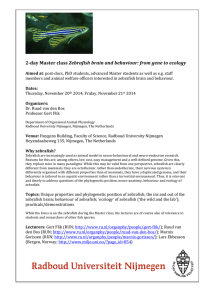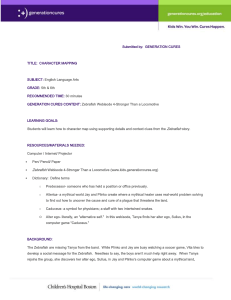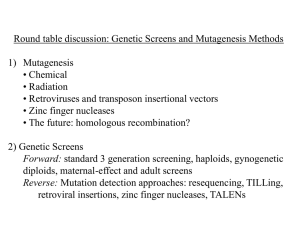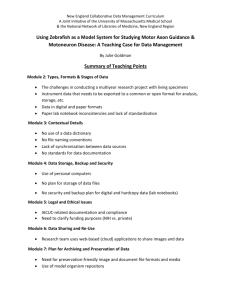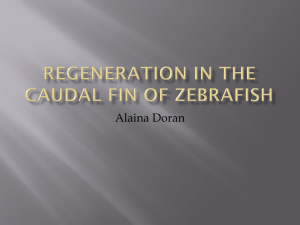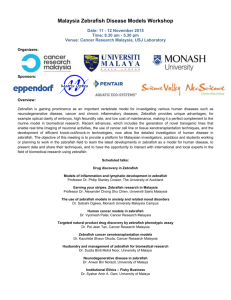Zebrafish Guidelines - UCSF Animal Care and Use Program
advertisement
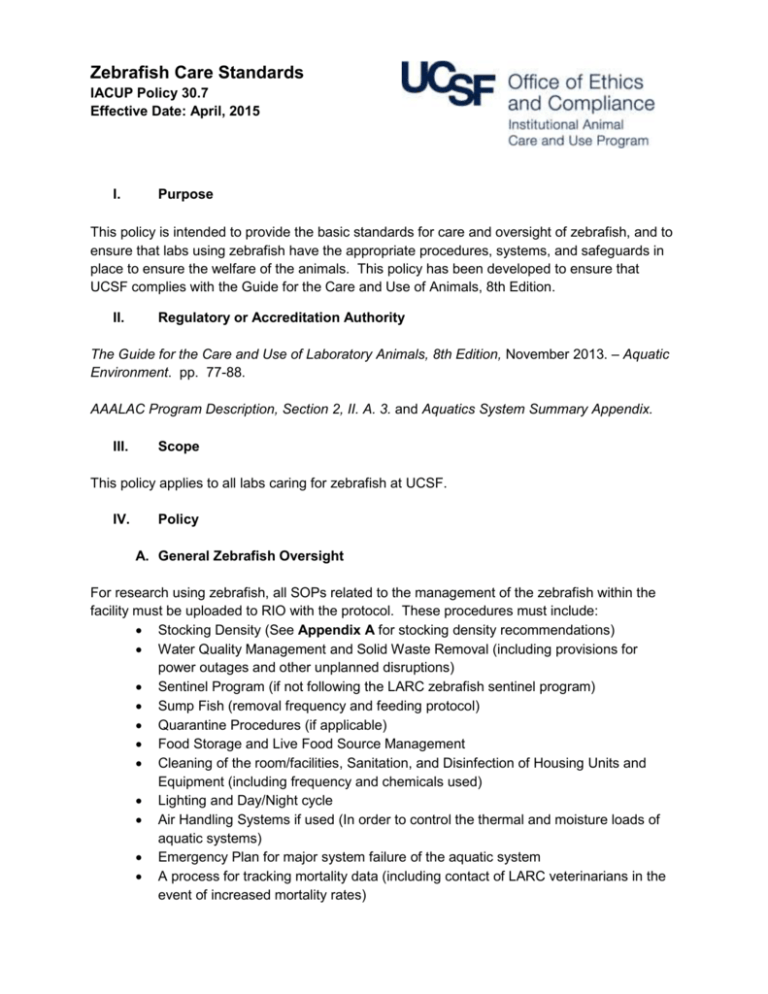
Zebrafish Care Standards IACUP Policy 30.7 Effective Date: April, 2015 I. Purpose This policy is intended to provide the basic standards for care and oversight of zebrafish, and to ensure that labs using zebrafish have the appropriate procedures, systems, and safeguards in place to ensure the welfare of the animals. This policy has been developed to ensure that UCSF complies with the Guide for the Care and Use of Animals, 8th Edition. II. Regulatory or Accreditation Authority The Guide for the Care and Use of Laboratory Animals, 8th Edition, November 2013. – Aquatic Environment. pp. 77-88. AAALAC Program Description, Section 2, II. A. 3. and Aquatics System Summary Appendix. III. Scope This policy applies to all labs caring for zebrafish at UCSF. IV. Policy A. General Zebrafish Oversight For research using zebrafish, all SOPs related to the management of the zebrafish within the facility must be uploaded to RIO with the protocol. These procedures must include: Stocking Density (See Appendix A for stocking density recommendations) Water Quality Management and Solid Waste Removal (including provisions for power outages and other unplanned disruptions) Sentinel Program (if not following the LARC zebrafish sentinel program) Sump Fish (removal frequency and feeding protocol) Quarantine Procedures (if applicable) Food Storage and Live Food Source Management Cleaning of the room/facilities, Sanitation, and Disinfection of Housing Units and Equipment (including frequency and chemicals used) Lighting and Day/Night cycle Air Handling Systems if used (In order to control the thermal and moisture loads of aquatic systems) Emergency Plan for major system failure of the aquatic system A process for tracking mortality data (including contact of LARC veterinarians in the event of increased mortality rates) PPE for staff when handling fish Standard Treatment (requires veterinary approval) Additionally, records must be maintained for water quality, animal numbers (taking into account transfers, breeding), mortality, and survival surgery and anesthesia if applicable. Zebrafish must also be observed daily by lab staff and the systems must be monitored daily, including weekends and holidays. B. Water Quality Water quality is the most critical aspect of zebrafish care. Labs using zebrafish must ensure that staff providing care are trained in water chemistry, water quality effects on animal health, how to monitor water quality, and how water quality affects life support system function. Water quality must be routinely monitored in accordance with the lab’s water quality SOP’s. (See Appendix B for a list of suggested monitoring parameters). C. Sentinel Program All labs are required to follow the LARC zebrafish sentinel program or a modified sentinel program that has been approved by the LARC veterinarians. All sentinel results must be provided to LARC veterinary staff for review. IACUC Appendices for Zebrafish Care Standards Appendices are provided as IACUC suggestions or recommendations. Deviation from the attached appendices may require IACUC approval. Appendix A: Zebrafish Stocking Density IACUC Approved: April 2015 The UCSF IACUC recommends a stocking density of 5 to 6 fish per liter for adult zebrafish. Up to 12 adult fish per liter may be permitted provided no animal welfare issues are identified. Stocking densities for zebrafish in the young and larval stages may be significantly higher. References: 1. The Guide for the Care and Use of Laboratory Animals, Eighth Edition. Natl. Academic Press (2013). 83 2. Matthews, M., Trevarrow, B. & Matthews, J. (2002) 'A virtual tour of the Guide for zebrafish users' Lab Animal 31 (3), p34-40 3. Brand, M., Granato, M. & Nüsslein-Volhard, C. (2002) ‘Keeping and raising zebrafish’ in NüssleinVolhard & Dahm (2002) Zebrafish - A Practical Approach ; Oxford University Press, Oxford, UK. 4. Vargesson, N.A. (2007) ‘Zebrafish’ in Manual of Animal Technology (ed. S. Barnett) Blackwell Publishing Ltd: Oxford, UK. 5. Castranova, D., et al. (2011). The Effect of Stocking Densities on Reproductive Performance in Laboratory Zebrafish (Danio rerio). Zebrafish, 8(3), 141-146. doi:10.1089/zeb.2011.0688 Appendix A: Recommended Water Quality Monitoring Parameters IACUC Approved: April 2015 Monitoring water quality is the most important requirement of zebrafish care. The following are a list of parameters which should be monitored by labs and included in the lab Standard Operating Procedures for Water Quality Management Temperature pH Alkalinity Nitrogen waste (Ammonia, Nitrate, Nitrite) Conductivity / salinity Hardness (osmality/dissolved minerals) Additionally, if your lab does not use DI water which has had the following parameters removed before it enters your system; the following parameters should be monitored as well: Chlorine / Bromine Phosphorous Oxidation reduction potential Dissolved Oxygen Total gas pressure Ion and metal content, and Microbial ecology




